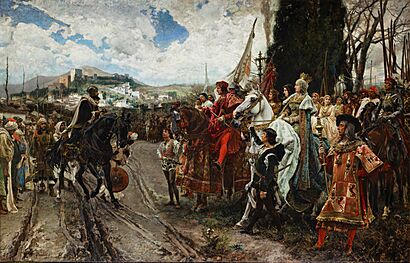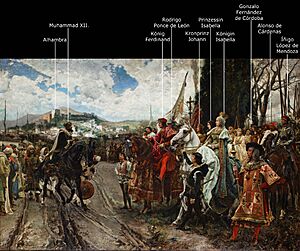The Surrender of Granada facts for kids
Quick facts for kids La rendición de Granada |
|
|---|---|
 |
|
| Artist | Francisco Pradilla Ortiz |
| Year | 1882 |
| Medium | Oil on canvas |
| Dimensions | 330 cm × 550 cm (130 in × 220 in) |
| Location | Palacio del Senado, Madrid, Spain |
La rendición de Granada (which means The Surrender of Granada in English) is a famous painting by the Spanish artist Francisco Pradilla Ortiz. He finished it in 1882. You can find this large painting in the Spanish Senate Palace in Madrid.
This huge painting, which is 3.3 meters tall and 5.5 meters wide, shows a very important moment in history. It pictures Boabdil, the last ruler of the Emirate of Granada, giving up his city to King Ferdinand and Queen Isabella on January 2, 1492. This event marked the end of the Reconquista, a long period when Christian kingdoms took back control of Spain from Muslim rule.
Why This Painting Was Made
The Spanish Senate asked Pradilla to create this painting. They wanted it after his earlier work, Doña Joanna the Mad, won big awards in 1878. That painting was a huge success!
The Senate wanted a painting that showed the capture of Granada. This event was seen as a symbol of "Spanish unity." It was also meant to represent "a starting point for the great deeds" of the Spanish people. The president of the Senate at the time, Marquis Manuel García Barzanallana, gave these instructions. The plan was to put the painting in the Senate's main meeting room. This room was going to be decorated with art about important Spanish history.
Even though The Surrender of Granada did not win as many awards as Doña Joanna the Mad, it was still a big success for Pradilla. It made him famous even outside of Spain. The painting was first shown in Rome, where Pradilla was leading the Spanish Academy. Later, it was displayed in the Senate in Spain. King Alfonso XII himself went to see the artwork.
After the painting was finished, King Alfonso XII gave Pradilla a special award called the Order of Isabella the Catholic. The Senate also paid the artist 50,000 pesetas. This was twice the amount they had first agreed to pay him!
What the Painting Shows
The painting shows the moment when Muhammad XII (Boabdil) hands over the keys to the city of Granada. He is giving them to the Catholic Monarchs of Spain, Queen Isabella and King Ferdinand. This happened on January 2, 1492.
On the right side of the painting, you can see the Christian conquerors. A small empty space separates them from the group of Muslim leaders. This space helps show depth in the painting.
Queen Isabella is easy to spot. She is in the front, wearing bright clothes that stand out against the dark trees behind her. She is riding a white horse. The queen wears a light green and gold dress. She also has a light blue cloak with a white fur collar. Her crown looks just like the real crown kept in Granada today.
King Ferdinand is shown next to her, dressed completely in red. He wears a red velvet cloak, red stockings, and a red hat with a crown. He has his right hand open, ready to take the keys. Between the King and Queen, you can see their two oldest children. Their son, Crown Prince John, is wearing a crown. Their daughter, Infanta Isabella, is dressed in black. She is in mourning because her husband, Alfonso of Portugal, had recently passed away. To the right, behind the queen, are other court ladies and important people from the conquest.
The group with Emir Muhammad XII is a bit further back in the painting. This makes them look smaller. The Emir is dressed in black and rides a black horse. A servant leads his horse. He holds the city keys in his right hand. His followers are not on horseback, but they still seem to be carrying weapons.
In the background of the painting, you can see a city wall and white buildings. On a mountain, you can also see the famous Alhambra castle.
Images for kids
See also
 In Spanish: La rendición de Granada para niños
In Spanish: La rendición de Granada para niños



